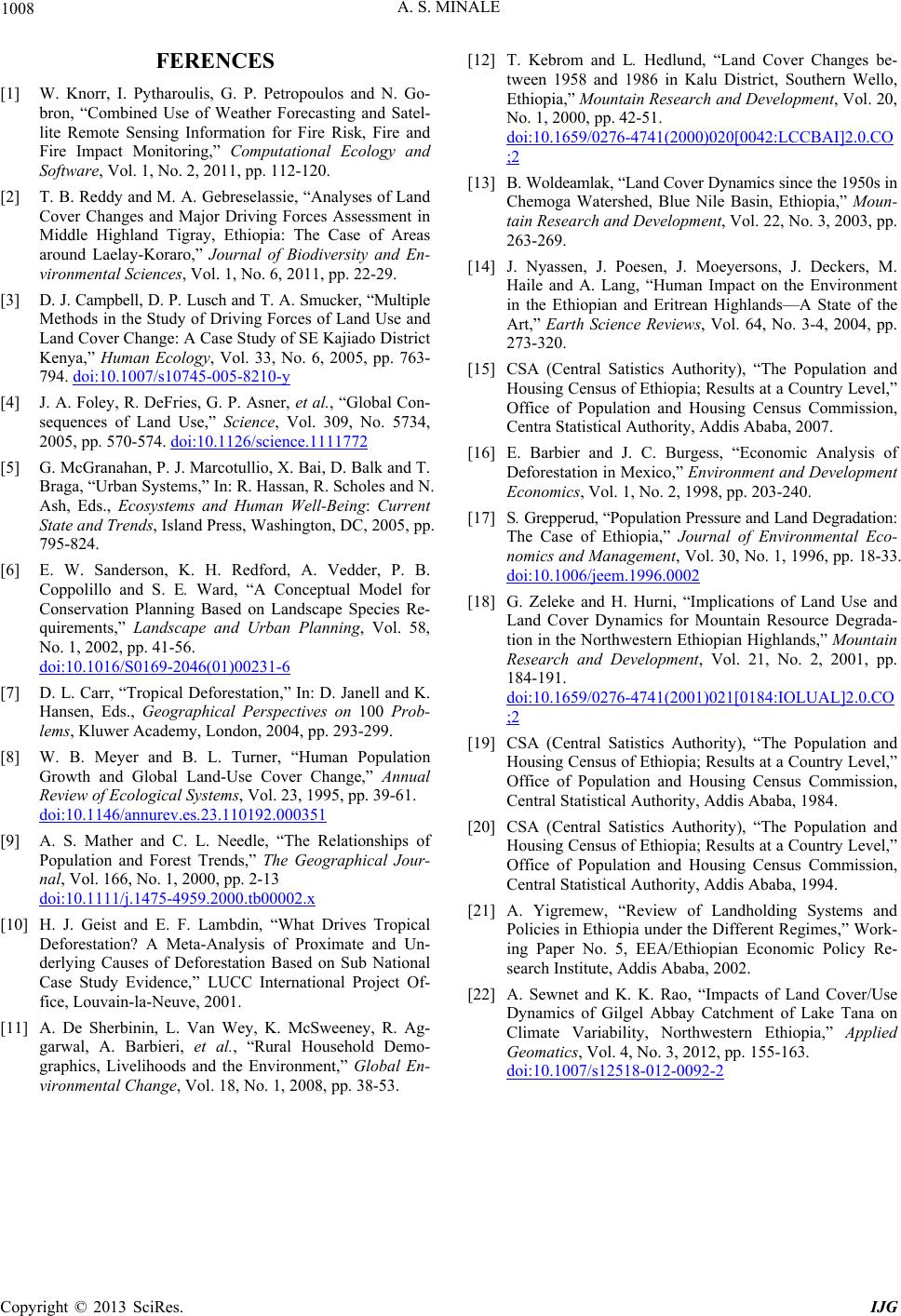
A. S. MINALE
Copyright © 2013 SciRes. IJG
1008
FERENCES
[1] W. Knorr, I. Pytharoulis, G. P. Petropoulos and N. Go-
bron, “Combined Use of Weather Forecasting and Satel-
lite Remote Sensing Information for Fire Risk, Fire and
Fire Impact Monitoring,” Computational Ecology and
Software, Vol. 1, No. 2, 2011, pp. 112-120.
[2] T. B. Reddy and M. A. Gebreselassie, “Analyses of Land
Cover Changes and Major Driving Forces Assessment in
Middle Highland Tigray, Ethiopia: The Case of Areas
around Laelay-Koraro,” Journal of Biodiversity and En-
vironmental Sciences, Vol. 1, No. 6, 2011, pp. 22-29.
[3] D. J. Campbell, D. P. Lusch and T. A. Smucker, “Multiple
Methods in the Study of Driving Forces of Land Use and
Land Cover Change: A Case Study of SE Kajiado District
Kenya,” Human Ecology, Vol. 33, No. 6, 2005, pp. 763-
794. doi:10.1007/s10745-005-8210-y
[4] J. A. Foley, R. DeFries, G. P. Asner, et al. , “Global Con-
sequences of Land Use,” Science, Vol. 309, No. 5734,
2005, pp. 570-574. doi:10.1126/science.1111772
[5] G. McGranahan, P. J. Marcotullio, X. Bai, D. Balk and T.
Braga, “Urban Systems,” In: R. Hassan, R. Scholes and N.
Ash, Eds., Ecosystems and Human Well-Being: Current
State and Trends, Island Press, Washington, DC, 2005, pp.
795-824.
[6] E. W. Sanderson, K. H. Redford, A. Vedder, P. B.
Coppolillo and S. E. Ward, “A Conceptual Model for
Conservation Planning Based on Landscape Species Re-
quirements,” Landscape and Urban Planning, Vol. 58,
No. 1, 2002, pp. 41-56.
doi:10.1016/S0169-2046(01)00231-6
[7] D. L. Carr, “Tropical Deforestation,” In: D. Janell and K.
Hansen, Eds., Geographical Perspectives on 100 Prob-
lems, Kluwer Academy, London, 2004, pp. 293-299.
[8] W. B. Meyer and B. L. Turner, “Human Population
Growth and Global Land-Use Cover Change,” Annual
Review of Ecological Systems, Vol. 23, 1995, pp. 39-61.
doi:10.1146/annurev.es.23.110192.000351
[9] A. S. Mather and C. L. Needle, “The Relationships of
Population and Forest Trends,” The Geographical Jour-
nal, Vol. 166, No. 1, 2000, pp. 2-13
doi:10.1111/j.1475-4959.2000.tb00002.x
[10] H. J. Geist and E. F. Lambdin, “What Drives Tropical
Deforestation? A Meta-Analysis of Proximate and Un-
derlying Causes of Deforestation Based on Sub National
Case Study Evidence,” LUCC International Project Of-
fice, Louvain-la- Neu ve , 2001.
[11] A. De Sherbinin, L. Van Wey, K. McSweeney, R. Ag-
garwal, A. Barbieri, et al., “Rural Household Demo-
graphics, Livelihoods and the Environment,” Global En-
vironmental Change, Vol. 18, No. 1, 2008, pp. 38-53.
[12] T. Kebrom and L. Hedlund, “Land Cover Changes be-
tween 1958 and 1986 in Kalu District, Southern Wello,
Ethiopia,” Mountain Research and Development, Vol. 20,
No. 1, 2000, pp. 42-51.
doi:10.1659/0276-4741(2000)020[0042:LCCBAI]2.0.CO
;2
[13] B. Woldeamlak, “Land Cover Dynamic s since the 1950s i n
Chemoga Watershed, Blue Nile Basin, Ethiopia,” Moun-
tain Research and Development, Vol. 22, No. 3, 2003, pp.
263-269.
[14] J. Nyassen, J. Poesen, J. Moeyersons, J. Deckers, M.
Haile and A. Lang, “Human Impact on the Environment
in the Ethiopian and Eritrean Highlands—A State of the
Art,” Earth Science Reviews, Vol. 64, No. 3-4, 2004, pp.
273-320.
[15] CSA (Central Satistics Authority), “The Population and
Housing Census of Ethiopia; Results at a Country Level,”
Office of Population and Housing Census Commission,
Centra Statistical Authority, Addis Ababa, 2007.
[16] E. Barbier and J. C. Burgess, “Economic Analysis of
Deforestation in Mexico,” Environment and Development
Economics, Vol. 1, No. 2, 1998, pp. 203-240.
[17] S. Grepperud, “Population Pressure and Land Degradation:
The Case of Ethiopia,” Journal of Environmental Eco-
nomics and Management, Vol. 30, No. 1, 1996, pp. 18-33.
doi:10.1006/jeem.1996.0002
[18] G. Zeleke and H. Hurni, “Implications of Land Use and
Land Cover Dynamics for Mountain Resource Degrada-
tion in the Northwestern Ethiopian Highlands,” Mountain
Research and Development, Vol. 21, No. 2, 2001, pp.
184-191.
doi:10.1659/0276-4741(2001)021[0184:IOLUAL]2.0.CO
;2
[19] CSA (Central Satistics Authority), “The Population and
Housing Census of Ethiopia; Results at a Country Level,”
Office of Population and Housing Census Commission,
Central Statistical Authority, Addis Ababa, 1984.
[20] CSA (Central Satistics Authority), “The Population and
Housing Census of Ethiopia; Results at a Country Level,”
Office of Population and Housing Census Commission,
Central Statistical Authority, Addis Ababa, 1994.
[21] A. Yigremew, “Review of Landholding Systems and
Policies in Ethiopia under the Different Regimes,” Work-
ing Paper No. 5, EEA/Ethiopian Economic Policy Re-
search Institute, A dd is Ababa, 2002.
[22] A. Sewnet and K. K. Rao, “Impacts of Land Cover/Use
Dynamics of Gilgel Abbay Catchment of Lake Tana on
Climate Variability, Northwestern Ethiopia,” Applied
Geomatics, Vol. 4, No. 3, 2012, pp. 155-163.
doi:10.1007/s12518-012-0092-2